Case Study Report: CSR Metric and Sourcing Analysis for Domino's Pizza
VerifiedAdded on 2023/06/08
|15
|3421
|360
Report
AI Summary
This case study report analyzes Domino's Pizza's CSR metrics and sourcing strategies. The report begins with an introduction to Domino's, including its background, products, and buyer behaviors. It examines decision factors like technology and manufacturing. The core of the report focuses on the CSR impact of sourcing raw materials (tomatoes, wheat, milk) and the environmental impact of operations. The SCOR process is illustrated with diagrams, followed by an evaluation of CSR metrics, including employee engagement and sustainability. The report details changes in sourcing tasks and calculates CSR metrics, including ROI. The 5 R Frameworks (Revenue, Reputation, Recruitment, Retention, Relationship) is discussed to measure CSR activities. It concludes with implications of introducing CSR metrics and the feasibility for small organizations.

Part A- Case Study Report
Paraphrase This Document
Need a fresh take? Get an instant paraphrase of this document with our AI Paraphraser

Table of Contents
Introduction...........................................................................................................................................3
Organization background......................................................................................................................3
Products and services............................................................................................................................3
Buyer’s behaviours segmentation.........................................................................................................3
Decision factors.....................................................................................................................................4
CSR impact of sourcing..........................................................................................................................4
SCOR process of selected organization..................................................................................................6
SCR metric evaluation............................................................................................................................7
Change sourcing tasks...........................................................................................................................8
CRS metric calculation...........................................................................................................................9
CSR-Metrics-ROI..................................................................................................................................13
Conclusion...........................................................................................................................................14
References...........................................................................................................................................15
List of figures
Figure 1: SCOR process of Domino's pizza in restaurant........................................................................6
Figure 2: SCOR process of domino's materials demands from supplier and pizza delivery.................7
Figure 3: record real time added in SCOR process of dominoes‐ ...........................................................8
Figure 4CRS metric calculation..............................................................................................................9
Introduction...........................................................................................................................................3
Organization background......................................................................................................................3
Products and services............................................................................................................................3
Buyer’s behaviours segmentation.........................................................................................................3
Decision factors.....................................................................................................................................4
CSR impact of sourcing..........................................................................................................................4
SCOR process of selected organization..................................................................................................6
SCR metric evaluation............................................................................................................................7
Change sourcing tasks...........................................................................................................................8
CRS metric calculation...........................................................................................................................9
CSR-Metrics-ROI..................................................................................................................................13
Conclusion...........................................................................................................................................14
References...........................................................................................................................................15
List of figures
Figure 1: SCOR process of Domino's pizza in restaurant........................................................................6
Figure 2: SCOR process of domino's materials demands from supplier and pizza delivery.................7
Figure 3: record real time added in SCOR process of dominoes‐ ...........................................................8
Figure 4CRS metric calculation..............................................................................................................9
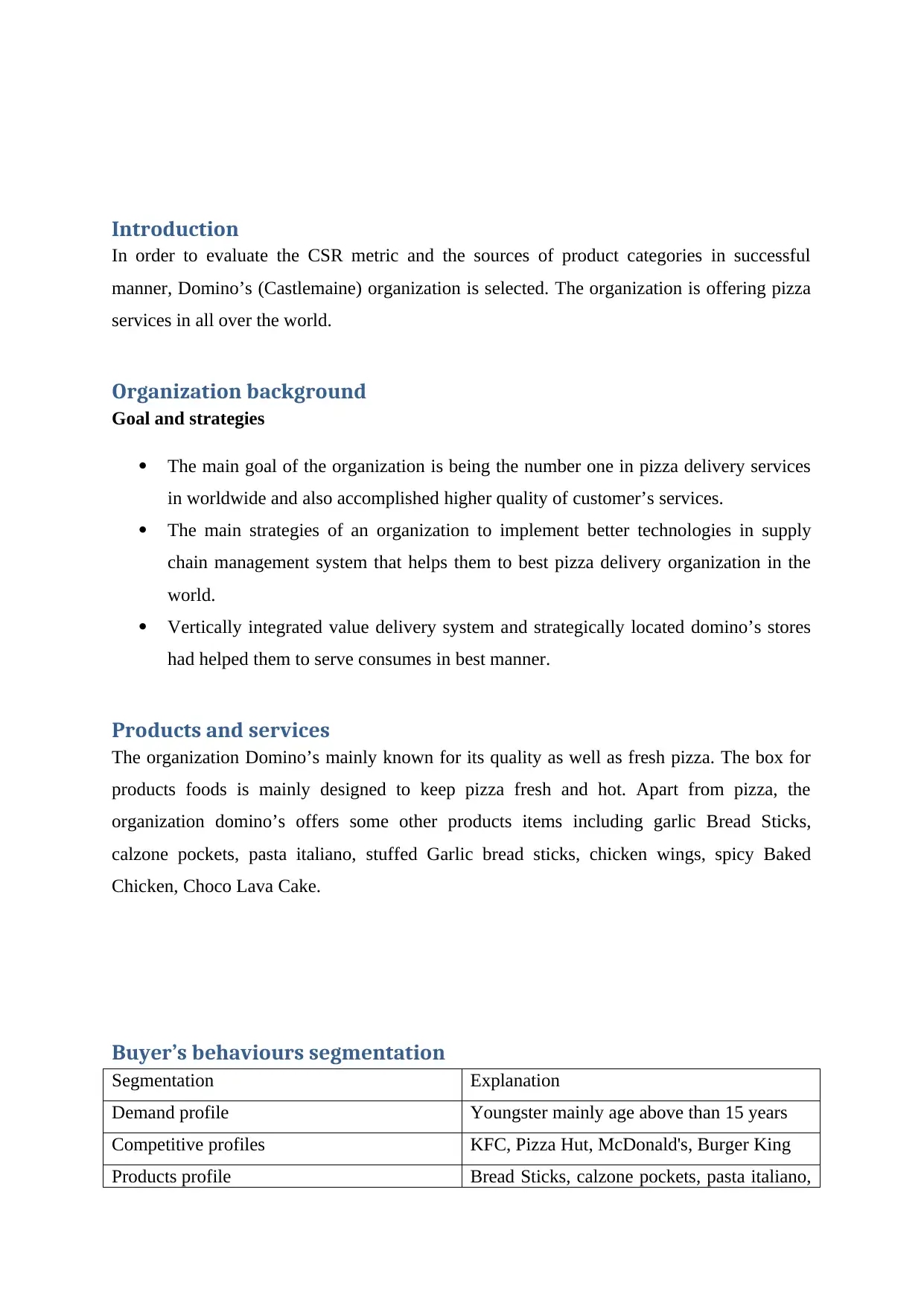
Introduction
In order to evaluate the CSR metric and the sources of product categories in successful
manner, Domino’s (Castlemaine) organization is selected. The organization is offering pizza
services in all over the world.
Organization background
Goal and strategies
The main goal of the organization is being the number one in pizza delivery services
in worldwide and also accomplished higher quality of customer’s services.
The main strategies of an organization to implement better technologies in supply
chain management system that helps them to best pizza delivery organization in the
world.
Vertically integrated value delivery system and strategically located domino’s stores
had helped them to serve consumes in best manner.
Products and services
The organization Domino’s mainly known for its quality as well as fresh pizza. The box for
products foods is mainly designed to keep pizza fresh and hot. Apart from pizza, the
organization domino’s offers some other products items including garlic Bread Sticks,
calzone pockets, pasta italiano, stuffed Garlic bread sticks, chicken wings, spicy Baked
Chicken, Choco Lava Cake.
Buyer’s behaviours segmentation
Segmentation Explanation
Demand profile Youngster mainly age above than 15 years
Competitive profiles KFC, Pizza Hut, McDonald's, Burger King
Products profile Bread Sticks, calzone pockets, pasta italiano,
In order to evaluate the CSR metric and the sources of product categories in successful
manner, Domino’s (Castlemaine) organization is selected. The organization is offering pizza
services in all over the world.
Organization background
Goal and strategies
The main goal of the organization is being the number one in pizza delivery services
in worldwide and also accomplished higher quality of customer’s services.
The main strategies of an organization to implement better technologies in supply
chain management system that helps them to best pizza delivery organization in the
world.
Vertically integrated value delivery system and strategically located domino’s stores
had helped them to serve consumes in best manner.
Products and services
The organization Domino’s mainly known for its quality as well as fresh pizza. The box for
products foods is mainly designed to keep pizza fresh and hot. Apart from pizza, the
organization domino’s offers some other products items including garlic Bread Sticks,
calzone pockets, pasta italiano, stuffed Garlic bread sticks, chicken wings, spicy Baked
Chicken, Choco Lava Cake.
Buyer’s behaviours segmentation
Segmentation Explanation
Demand profile Youngster mainly age above than 15 years
Competitive profiles KFC, Pizza Hut, McDonald's, Burger King
Products profile Bread Sticks, calzone pockets, pasta italiano,
⊘ This is a preview!⊘
Do you want full access?
Subscribe today to unlock all pages.

Trusted by 1+ million students worldwide
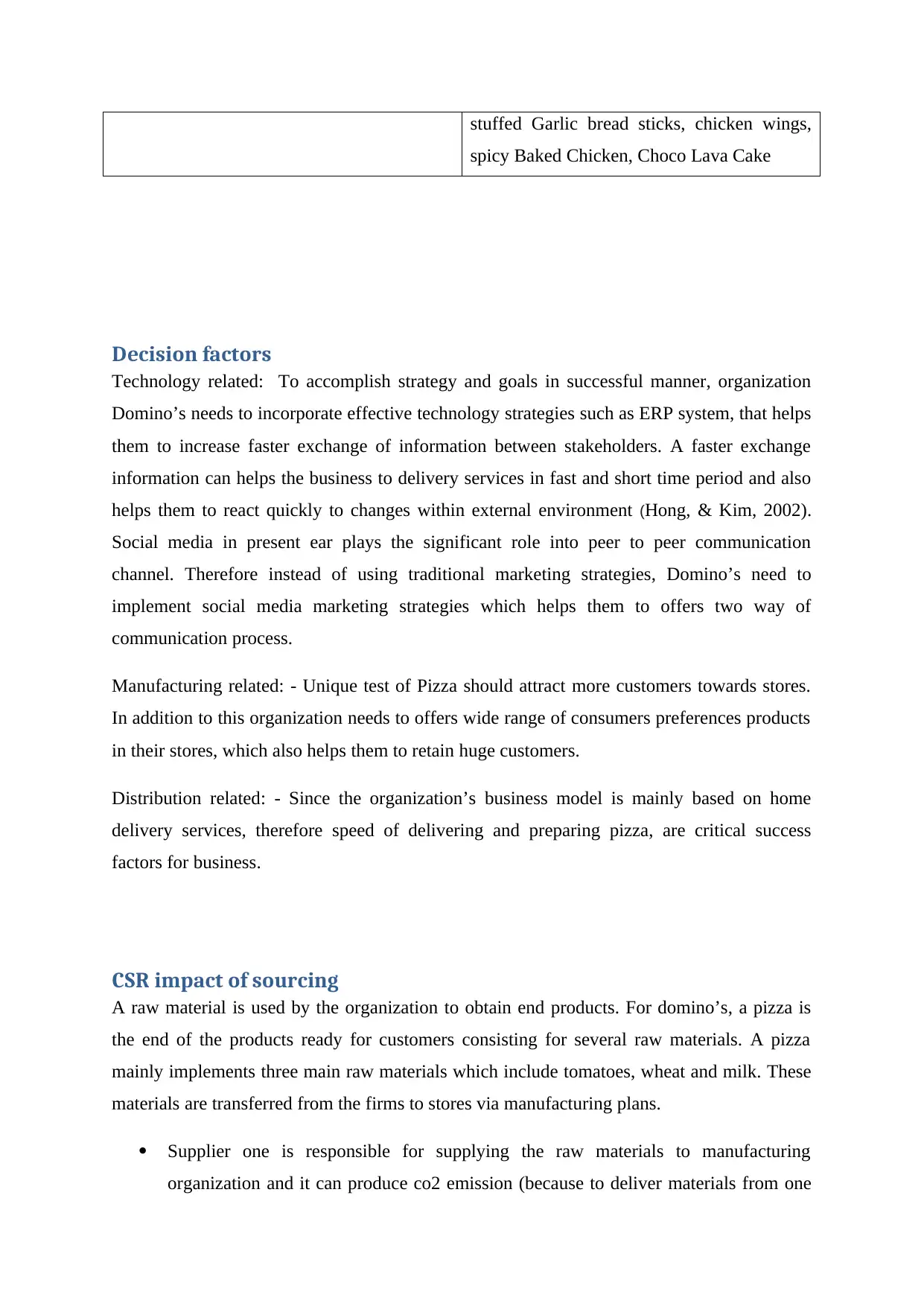
stuffed Garlic bread sticks, chicken wings,
spicy Baked Chicken, Choco Lava Cake
Decision factors
Technology related: To accomplish strategy and goals in successful manner, organization
Domino’s needs to incorporate effective technology strategies such as ERP system, that helps
them to increase faster exchange of information between stakeholders. A faster exchange
information can helps the business to delivery services in fast and short time period and also
helps them to react quickly to changes within external environment (Hong, & Kim, 2002).
Social media in present ear plays the significant role into peer to peer communication
channel. Therefore instead of using traditional marketing strategies, Domino’s need to
implement social media marketing strategies which helps them to offers two way of
communication process.
Manufacturing related: - Unique test of Pizza should attract more customers towards stores.
In addition to this organization needs to offers wide range of consumers preferences products
in their stores, which also helps them to retain huge customers.
Distribution related: - Since the organization’s business model is mainly based on home
delivery services, therefore speed of delivering and preparing pizza, are critical success
factors for business.
CSR impact of sourcing
A raw material is used by the organization to obtain end products. For domino’s, a pizza is
the end of the products ready for customers consisting for several raw materials. A pizza
mainly implements three main raw materials which include tomatoes, wheat and milk. These
materials are transferred from the firms to stores via manufacturing plans.
Supplier one is responsible for supplying the raw materials to manufacturing
organization and it can produce co2 emission (because to deliver materials from one
spicy Baked Chicken, Choco Lava Cake
Decision factors
Technology related: To accomplish strategy and goals in successful manner, organization
Domino’s needs to incorporate effective technology strategies such as ERP system, that helps
them to increase faster exchange of information between stakeholders. A faster exchange
information can helps the business to delivery services in fast and short time period and also
helps them to react quickly to changes within external environment (Hong, & Kim, 2002).
Social media in present ear plays the significant role into peer to peer communication
channel. Therefore instead of using traditional marketing strategies, Domino’s need to
implement social media marketing strategies which helps them to offers two way of
communication process.
Manufacturing related: - Unique test of Pizza should attract more customers towards stores.
In addition to this organization needs to offers wide range of consumers preferences products
in their stores, which also helps them to retain huge customers.
Distribution related: - Since the organization’s business model is mainly based on home
delivery services, therefore speed of delivering and preparing pizza, are critical success
factors for business.
CSR impact of sourcing
A raw material is used by the organization to obtain end products. For domino’s, a pizza is
the end of the products ready for customers consisting for several raw materials. A pizza
mainly implements three main raw materials which include tomatoes, wheat and milk. These
materials are transferred from the firms to stores via manufacturing plans.
Supplier one is responsible for supplying the raw materials to manufacturing
organization and it can produce co2 emission (because to deliver materials from one
Paraphrase This Document
Need a fresh take? Get an instant paraphrase of this document with our AI Paraphraser
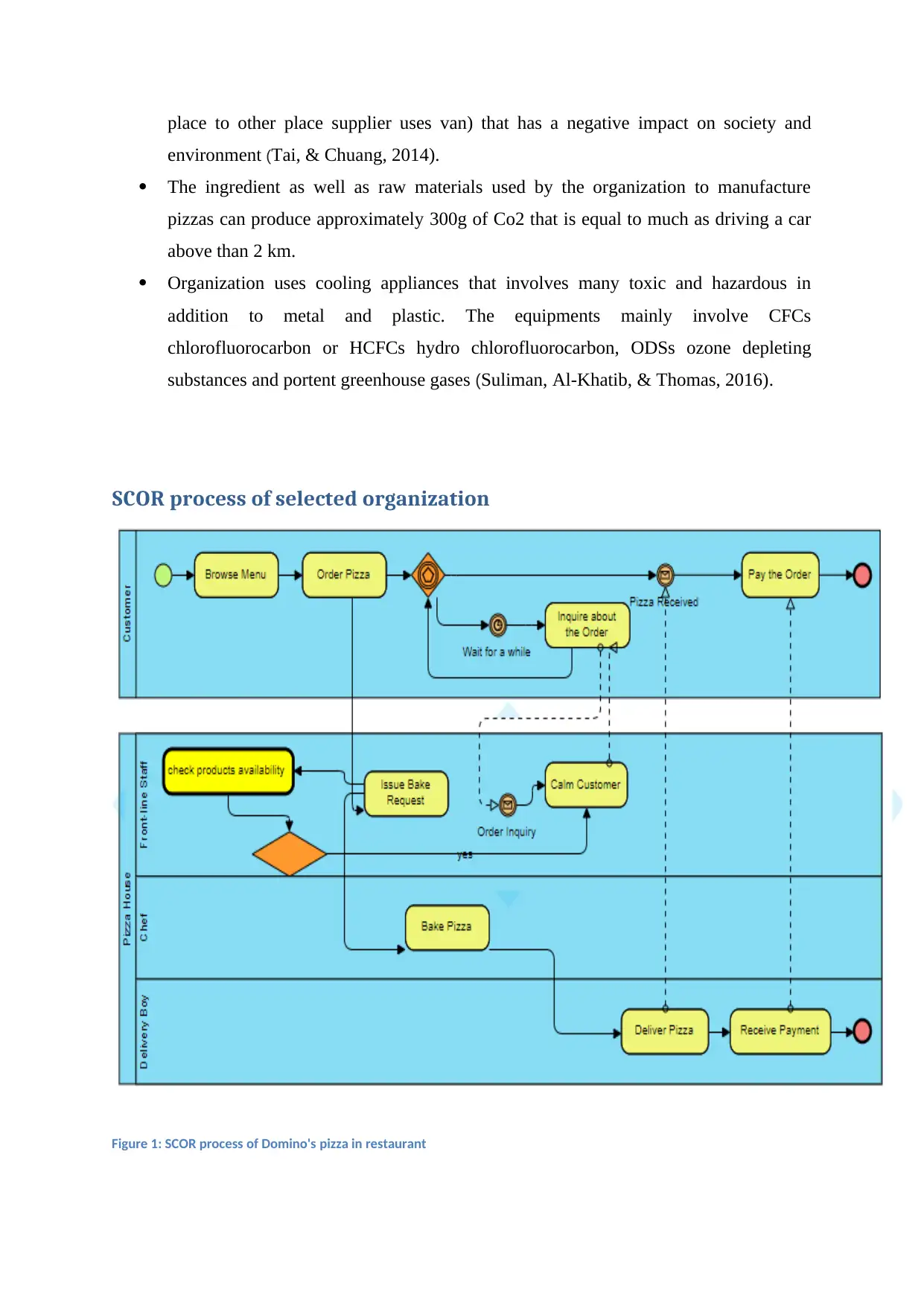
place to other place supplier uses van) that has a negative impact on society and
environment (Tai, & Chuang, 2014).
The ingredient as well as raw materials used by the organization to manufacture
pizzas can produce approximately 300g of Co2 that is equal to much as driving a car
above than 2 km.
Organization uses cooling appliances that involves many toxic and hazardous in
addition to metal and plastic. The equipments mainly involve CFCs
chlorofluorocarbon or HCFCs hydro chlorofluorocarbon, ODSs ozone depleting
substances and portent greenhouse gases (Suliman, Al-Khatib, & Thomas, 2016).
SCOR process of selected organization
Figure 1: SCOR process of Domino's pizza in restaurant
environment (Tai, & Chuang, 2014).
The ingredient as well as raw materials used by the organization to manufacture
pizzas can produce approximately 300g of Co2 that is equal to much as driving a car
above than 2 km.
Organization uses cooling appliances that involves many toxic and hazardous in
addition to metal and plastic. The equipments mainly involve CFCs
chlorofluorocarbon or HCFCs hydro chlorofluorocarbon, ODSs ozone depleting
substances and portent greenhouse gases (Suliman, Al-Khatib, & Thomas, 2016).
SCOR process of selected organization
Figure 1: SCOR process of Domino's pizza in restaurant
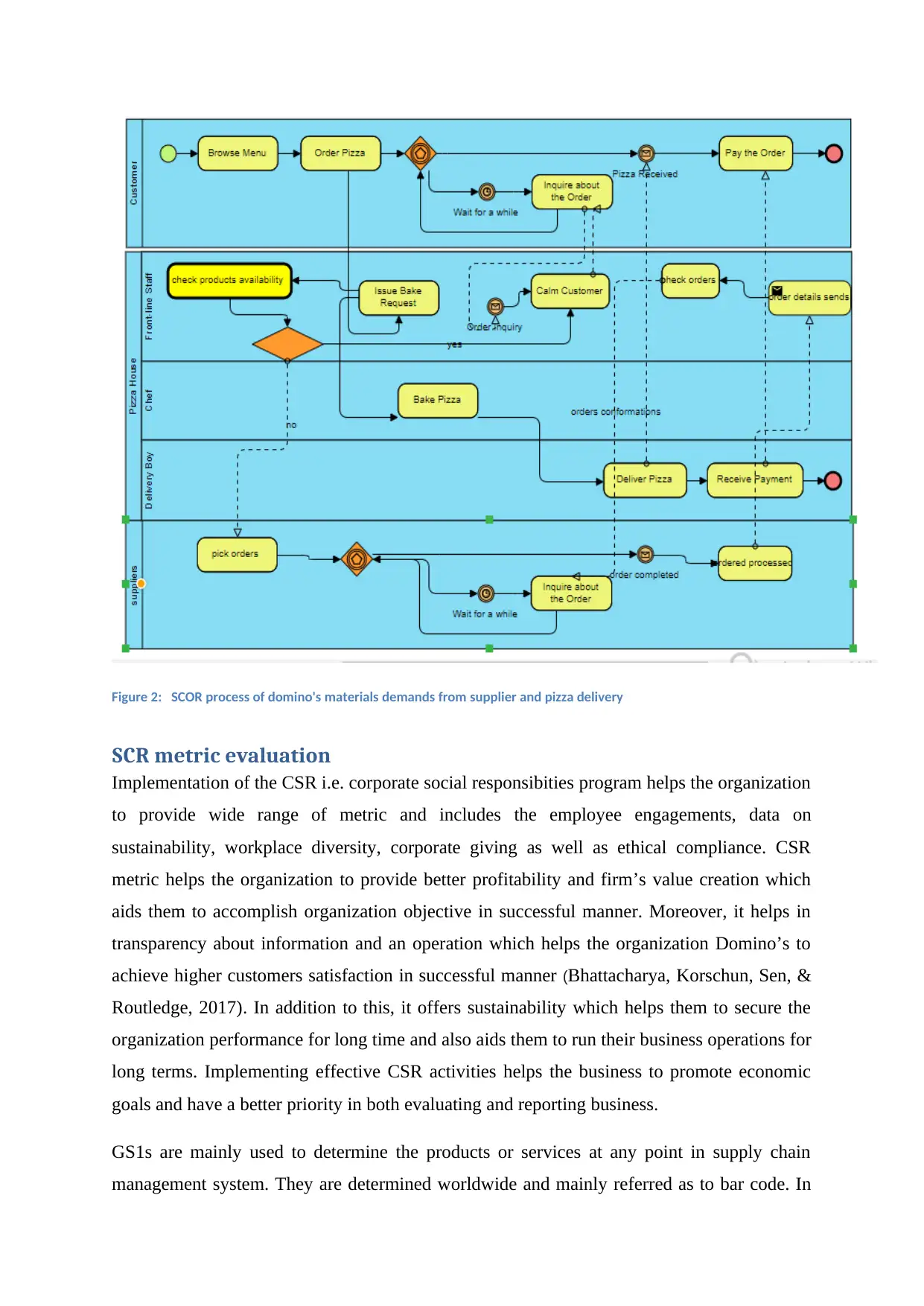
Figure 2: SCOR process of domino's materials demands from supplier and pizza delivery
SCR metric evaluation
Implementation of the CSR i.e. corporate social responsibities program helps the organization
to provide wide range of metric and includes the employee engagements, data on
sustainability, workplace diversity, corporate giving as well as ethical compliance. CSR
metric helps the organization to provide better profitability and firm’s value creation which
aids them to accomplish organization objective in successful manner. Moreover, it helps in
transparency about information and an operation which helps the organization Domino’s to
achieve higher customers satisfaction in successful manner (Bhattacharya, Korschun, Sen, &
Routledge, 2017). In addition to this, it offers sustainability which helps them to secure the
organization performance for long time and also aids them to run their business operations for
long terms. Implementing effective CSR activities helps the business to promote economic
goals and have a better priority in both evaluating and reporting business.
GS1s are mainly used to determine the products or services at any point in supply chain
management system. They are determined worldwide and mainly referred as to bar code. In
SCR metric evaluation
Implementation of the CSR i.e. corporate social responsibities program helps the organization
to provide wide range of metric and includes the employee engagements, data on
sustainability, workplace diversity, corporate giving as well as ethical compliance. CSR
metric helps the organization to provide better profitability and firm’s value creation which
aids them to accomplish organization objective in successful manner. Moreover, it helps in
transparency about information and an operation which helps the organization Domino’s to
achieve higher customers satisfaction in successful manner (Bhattacharya, Korschun, Sen, &
Routledge, 2017). In addition to this, it offers sustainability which helps them to secure the
organization performance for long time and also aids them to run their business operations for
long terms. Implementing effective CSR activities helps the business to promote economic
goals and have a better priority in both evaluating and reporting business.
GS1s are mainly used to determine the products or services at any point in supply chain
management system. They are determined worldwide and mainly referred as to bar code. In
⊘ This is a preview!⊘
Do you want full access?
Subscribe today to unlock all pages.

Trusted by 1+ million students worldwide
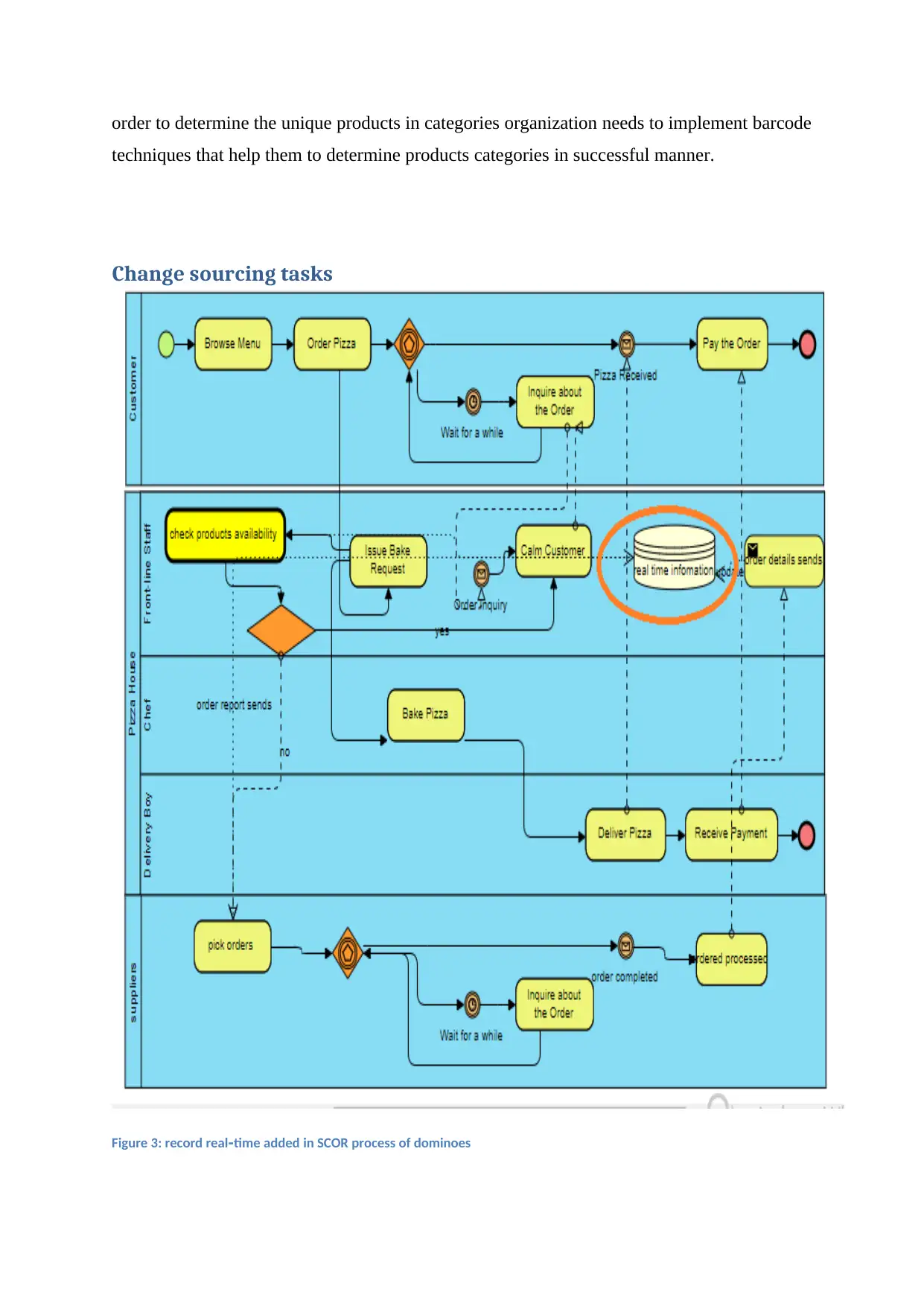
order to determine the unique products in categories organization needs to implement barcode
techniques that help them to determine products categories in successful manner.
Change sourcing tasks
Figure 3: record real time added in SCOR process of dominoes‐
techniques that help them to determine products categories in successful manner.
Change sourcing tasks
Figure 3: record real time added in SCOR process of dominoes‐
Paraphrase This Document
Need a fresh take? Get an instant paraphrase of this document with our AI Paraphraser
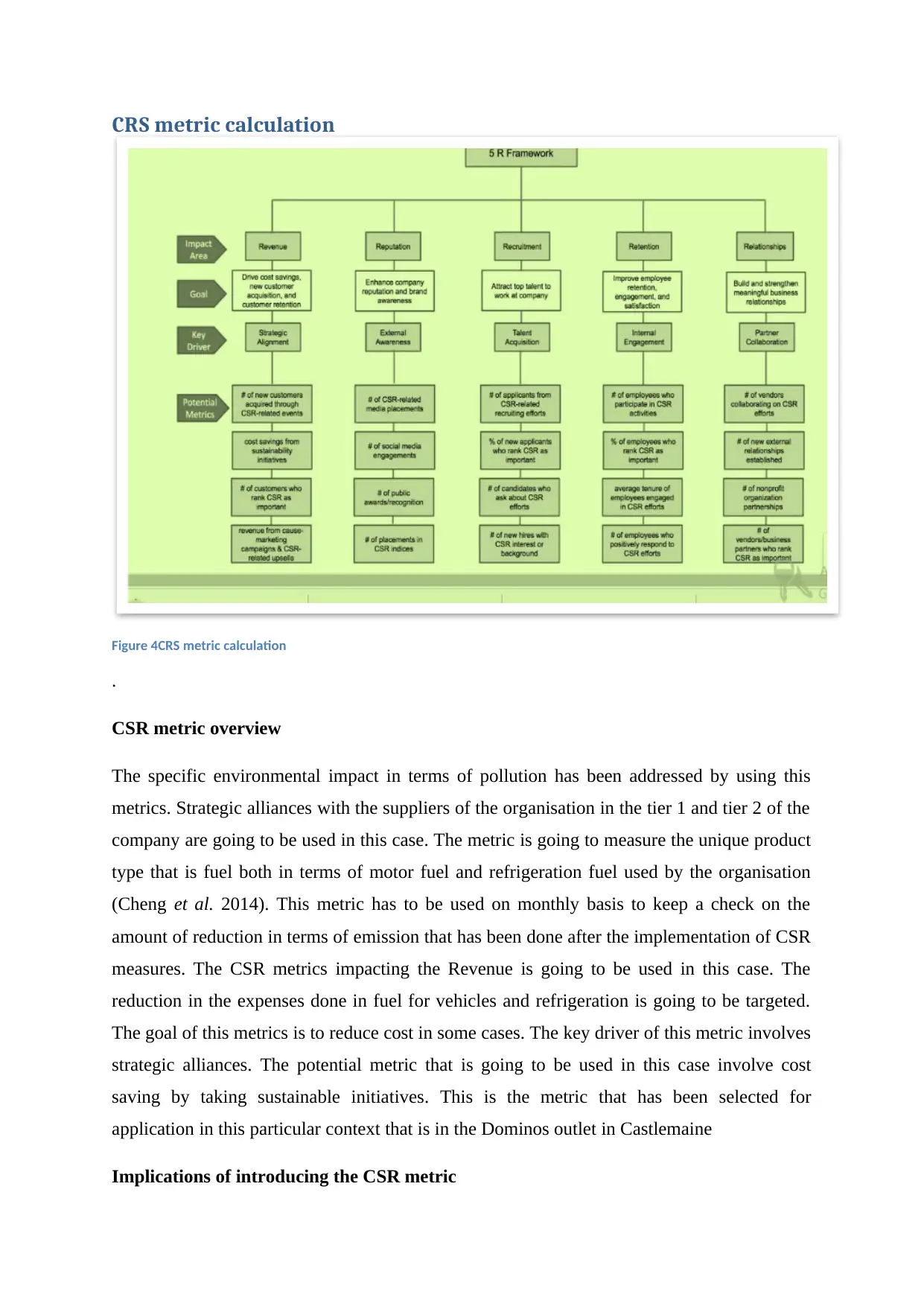
CRS metric calculation
Figure 4CRS metric calculation
.
CSR metric overview
The specific environmental impact in terms of pollution has been addressed by using this
metrics. Strategic alliances with the suppliers of the organisation in the tier 1 and tier 2 of the
company are going to be used in this case. The metric is going to measure the unique product
type that is fuel both in terms of motor fuel and refrigeration fuel used by the organisation
(Cheng et al. 2014). This metric has to be used on monthly basis to keep a check on the
amount of reduction in terms of emission that has been done after the implementation of CSR
measures. The CSR metrics impacting the Revenue is going to be used in this case. The
reduction in the expenses done in fuel for vehicles and refrigeration is going to be targeted.
The goal of this metrics is to reduce cost in some cases. The key driver of this metric involves
strategic alliances. The potential metric that is going to be used in this case involve cost
saving by taking sustainable initiatives. This is the metric that has been selected for
application in this particular context that is in the Dominos outlet in Castlemaine
Implications of introducing the CSR metric
Figure 4CRS metric calculation
.
CSR metric overview
The specific environmental impact in terms of pollution has been addressed by using this
metrics. Strategic alliances with the suppliers of the organisation in the tier 1 and tier 2 of the
company are going to be used in this case. The metric is going to measure the unique product
type that is fuel both in terms of motor fuel and refrigeration fuel used by the organisation
(Cheng et al. 2014). This metric has to be used on monthly basis to keep a check on the
amount of reduction in terms of emission that has been done after the implementation of CSR
measures. The CSR metrics impacting the Revenue is going to be used in this case. The
reduction in the expenses done in fuel for vehicles and refrigeration is going to be targeted.
The goal of this metrics is to reduce cost in some cases. The key driver of this metric involves
strategic alliances. The potential metric that is going to be used in this case involve cost
saving by taking sustainable initiatives. This is the metric that has been selected for
application in this particular context that is in the Dominos outlet in Castlemaine
Implications of introducing the CSR metric
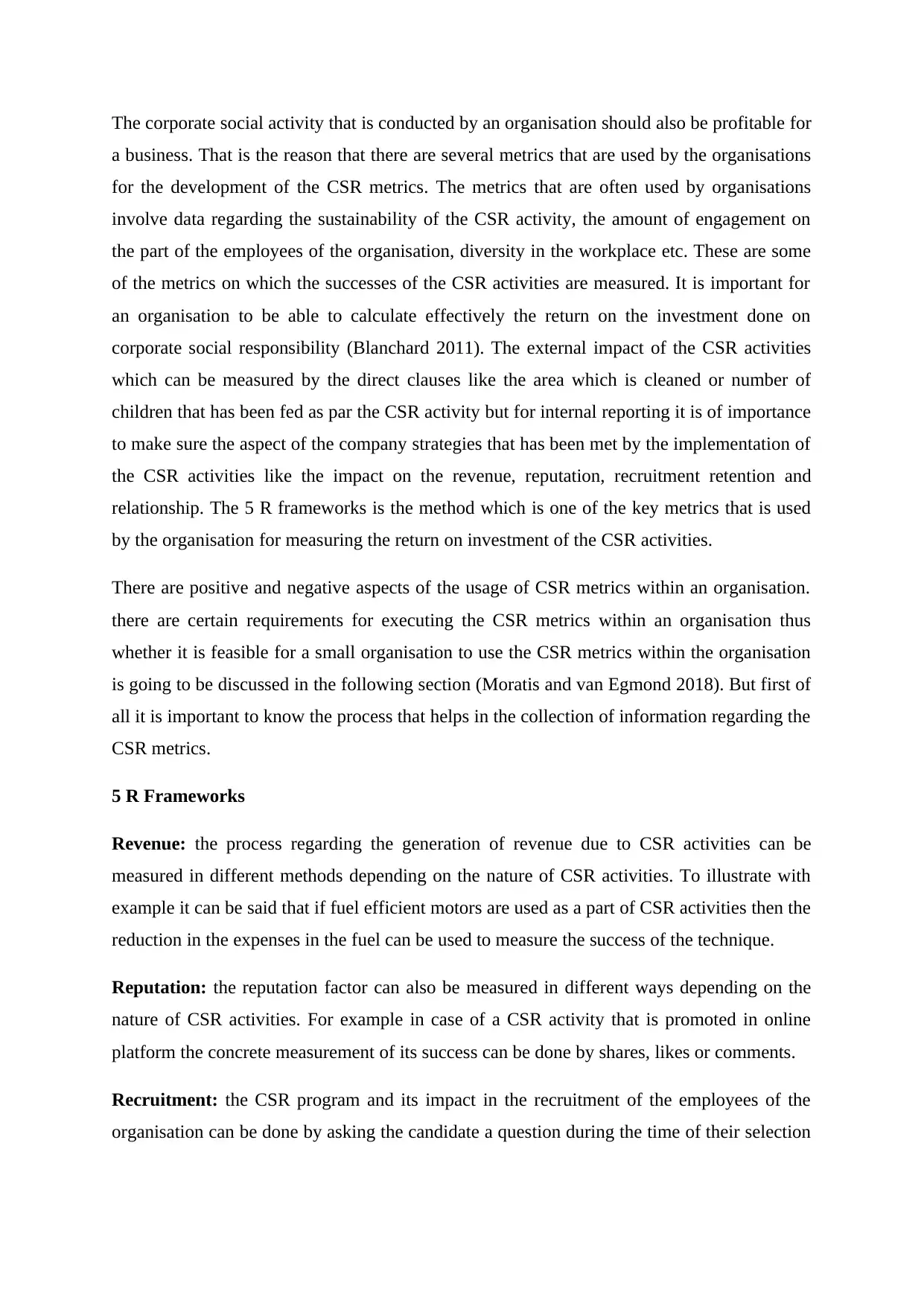
The corporate social activity that is conducted by an organisation should also be profitable for
a business. That is the reason that there are several metrics that are used by the organisations
for the development of the CSR metrics. The metrics that are often used by organisations
involve data regarding the sustainability of the CSR activity, the amount of engagement on
the part of the employees of the organisation, diversity in the workplace etc. These are some
of the metrics on which the successes of the CSR activities are measured. It is important for
an organisation to be able to calculate effectively the return on the investment done on
corporate social responsibility (Blanchard 2011). The external impact of the CSR activities
which can be measured by the direct clauses like the area which is cleaned or number of
children that has been fed as par the CSR activity but for internal reporting it is of importance
to make sure the aspect of the company strategies that has been met by the implementation of
the CSR activities like the impact on the revenue, reputation, recruitment retention and
relationship. The 5 R frameworks is the method which is one of the key metrics that is used
by the organisation for measuring the return on investment of the CSR activities.
There are positive and negative aspects of the usage of CSR metrics within an organisation.
there are certain requirements for executing the CSR metrics within an organisation thus
whether it is feasible for a small organisation to use the CSR metrics within the organisation
is going to be discussed in the following section (Moratis and van Egmond 2018). But first of
all it is important to know the process that helps in the collection of information regarding the
CSR metrics.
5 R Frameworks
Revenue: the process regarding the generation of revenue due to CSR activities can be
measured in different methods depending on the nature of CSR activities. To illustrate with
example it can be said that if fuel efficient motors are used as a part of CSR activities then the
reduction in the expenses in the fuel can be used to measure the success of the technique.
Reputation: the reputation factor can also be measured in different ways depending on the
nature of CSR activities. For example in case of a CSR activity that is promoted in online
platform the concrete measurement of its success can be done by shares, likes or comments.
Recruitment: the CSR program and its impact in the recruitment of the employees of the
organisation can be done by asking the candidate a question during the time of their selection
a business. That is the reason that there are several metrics that are used by the organisations
for the development of the CSR metrics. The metrics that are often used by organisations
involve data regarding the sustainability of the CSR activity, the amount of engagement on
the part of the employees of the organisation, diversity in the workplace etc. These are some
of the metrics on which the successes of the CSR activities are measured. It is important for
an organisation to be able to calculate effectively the return on the investment done on
corporate social responsibility (Blanchard 2011). The external impact of the CSR activities
which can be measured by the direct clauses like the area which is cleaned or number of
children that has been fed as par the CSR activity but for internal reporting it is of importance
to make sure the aspect of the company strategies that has been met by the implementation of
the CSR activities like the impact on the revenue, reputation, recruitment retention and
relationship. The 5 R frameworks is the method which is one of the key metrics that is used
by the organisation for measuring the return on investment of the CSR activities.
There are positive and negative aspects of the usage of CSR metrics within an organisation.
there are certain requirements for executing the CSR metrics within an organisation thus
whether it is feasible for a small organisation to use the CSR metrics within the organisation
is going to be discussed in the following section (Moratis and van Egmond 2018). But first of
all it is important to know the process that helps in the collection of information regarding the
CSR metrics.
5 R Frameworks
Revenue: the process regarding the generation of revenue due to CSR activities can be
measured in different methods depending on the nature of CSR activities. To illustrate with
example it can be said that if fuel efficient motors are used as a part of CSR activities then the
reduction in the expenses in the fuel can be used to measure the success of the technique.
Reputation: the reputation factor can also be measured in different ways depending on the
nature of CSR activities. For example in case of a CSR activity that is promoted in online
platform the concrete measurement of its success can be done by shares, likes or comments.
Recruitment: the CSR program and its impact in the recruitment of the employees of the
organisation can be done by asking the candidate a question during the time of their selection
⊘ This is a preview!⊘
Do you want full access?
Subscribe today to unlock all pages.

Trusted by 1+ million students worldwide
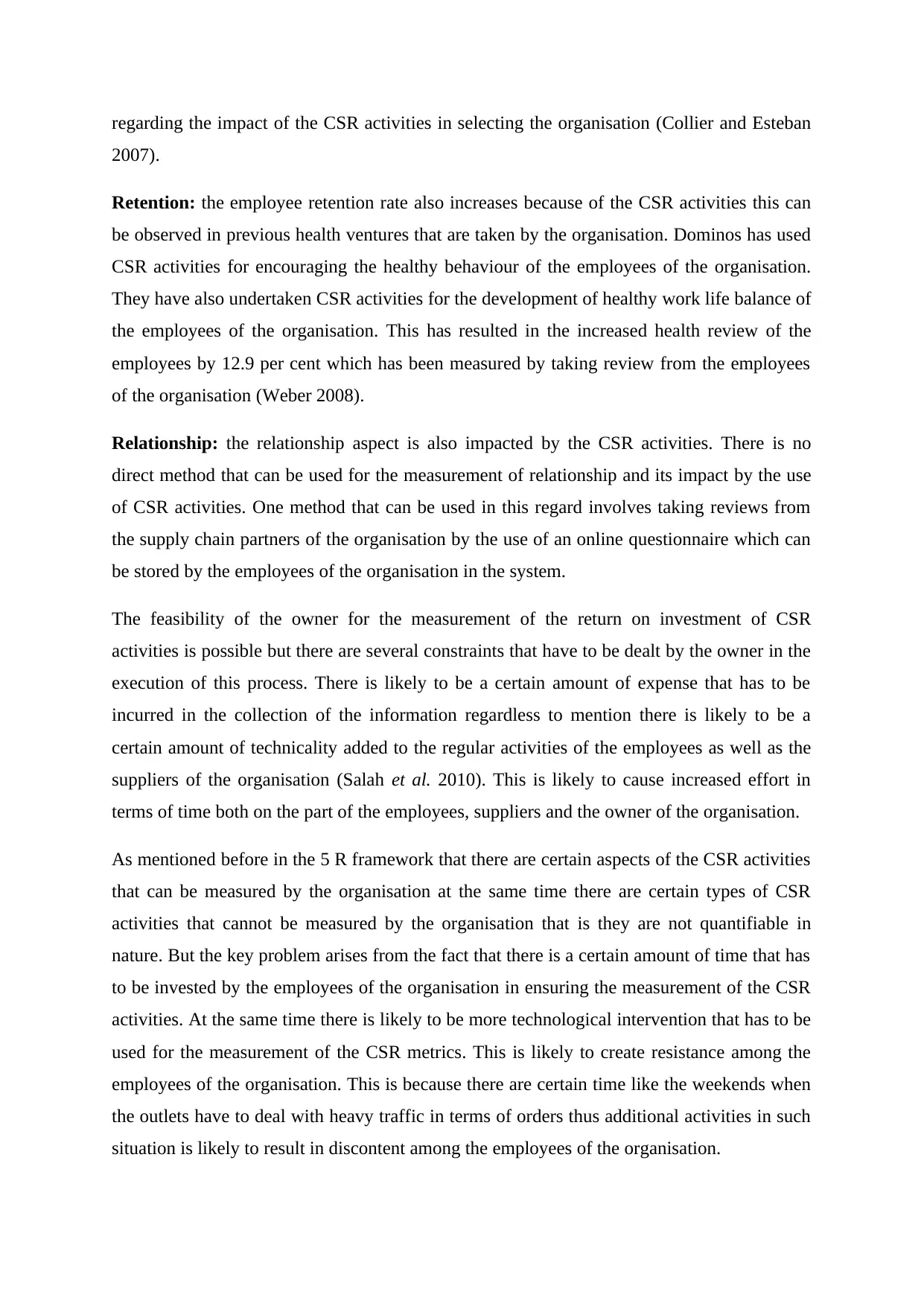
regarding the impact of the CSR activities in selecting the organisation (Collier and Esteban
2007).
Retention: the employee retention rate also increases because of the CSR activities this can
be observed in previous health ventures that are taken by the organisation. Dominos has used
CSR activities for encouraging the healthy behaviour of the employees of the organisation.
They have also undertaken CSR activities for the development of healthy work life balance of
the employees of the organisation. This has resulted in the increased health review of the
employees by 12.9 per cent which has been measured by taking review from the employees
of the organisation (Weber 2008).
Relationship: the relationship aspect is also impacted by the CSR activities. There is no
direct method that can be used for the measurement of relationship and its impact by the use
of CSR activities. One method that can be used in this regard involves taking reviews from
the supply chain partners of the organisation by the use of an online questionnaire which can
be stored by the employees of the organisation in the system.
The feasibility of the owner for the measurement of the return on investment of CSR
activities is possible but there are several constraints that have to be dealt by the owner in the
execution of this process. There is likely to be a certain amount of expense that has to be
incurred in the collection of the information regardless to mention there is likely to be a
certain amount of technicality added to the regular activities of the employees as well as the
suppliers of the organisation (Salah et al. 2010). This is likely to cause increased effort in
terms of time both on the part of the employees, suppliers and the owner of the organisation.
As mentioned before in the 5 R framework that there are certain aspects of the CSR activities
that can be measured by the organisation at the same time there are certain types of CSR
activities that cannot be measured by the organisation that is they are not quantifiable in
nature. But the key problem arises from the fact that there is a certain amount of time that has
to be invested by the employees of the organisation in ensuring the measurement of the CSR
activities. At the same time there is likely to be more technological intervention that has to be
used for the measurement of the CSR metrics. This is likely to create resistance among the
employees of the organisation. This is because there are certain time like the weekends when
the outlets have to deal with heavy traffic in terms of orders thus additional activities in such
situation is likely to result in discontent among the employees of the organisation.
2007).
Retention: the employee retention rate also increases because of the CSR activities this can
be observed in previous health ventures that are taken by the organisation. Dominos has used
CSR activities for encouraging the healthy behaviour of the employees of the organisation.
They have also undertaken CSR activities for the development of healthy work life balance of
the employees of the organisation. This has resulted in the increased health review of the
employees by 12.9 per cent which has been measured by taking review from the employees
of the organisation (Weber 2008).
Relationship: the relationship aspect is also impacted by the CSR activities. There is no
direct method that can be used for the measurement of relationship and its impact by the use
of CSR activities. One method that can be used in this regard involves taking reviews from
the supply chain partners of the organisation by the use of an online questionnaire which can
be stored by the employees of the organisation in the system.
The feasibility of the owner for the measurement of the return on investment of CSR
activities is possible but there are several constraints that have to be dealt by the owner in the
execution of this process. There is likely to be a certain amount of expense that has to be
incurred in the collection of the information regardless to mention there is likely to be a
certain amount of technicality added to the regular activities of the employees as well as the
suppliers of the organisation (Salah et al. 2010). This is likely to cause increased effort in
terms of time both on the part of the employees, suppliers and the owner of the organisation.
As mentioned before in the 5 R framework that there are certain aspects of the CSR activities
that can be measured by the organisation at the same time there are certain types of CSR
activities that cannot be measured by the organisation that is they are not quantifiable in
nature. But the key problem arises from the fact that there is a certain amount of time that has
to be invested by the employees of the organisation in ensuring the measurement of the CSR
activities. At the same time there is likely to be more technological intervention that has to be
used for the measurement of the CSR metrics. This is likely to create resistance among the
employees of the organisation. This is because there are certain time like the weekends when
the outlets have to deal with heavy traffic in terms of orders thus additional activities in such
situation is likely to result in discontent among the employees of the organisation.
Paraphrase This Document
Need a fresh take? Get an instant paraphrase of this document with our AI Paraphraser
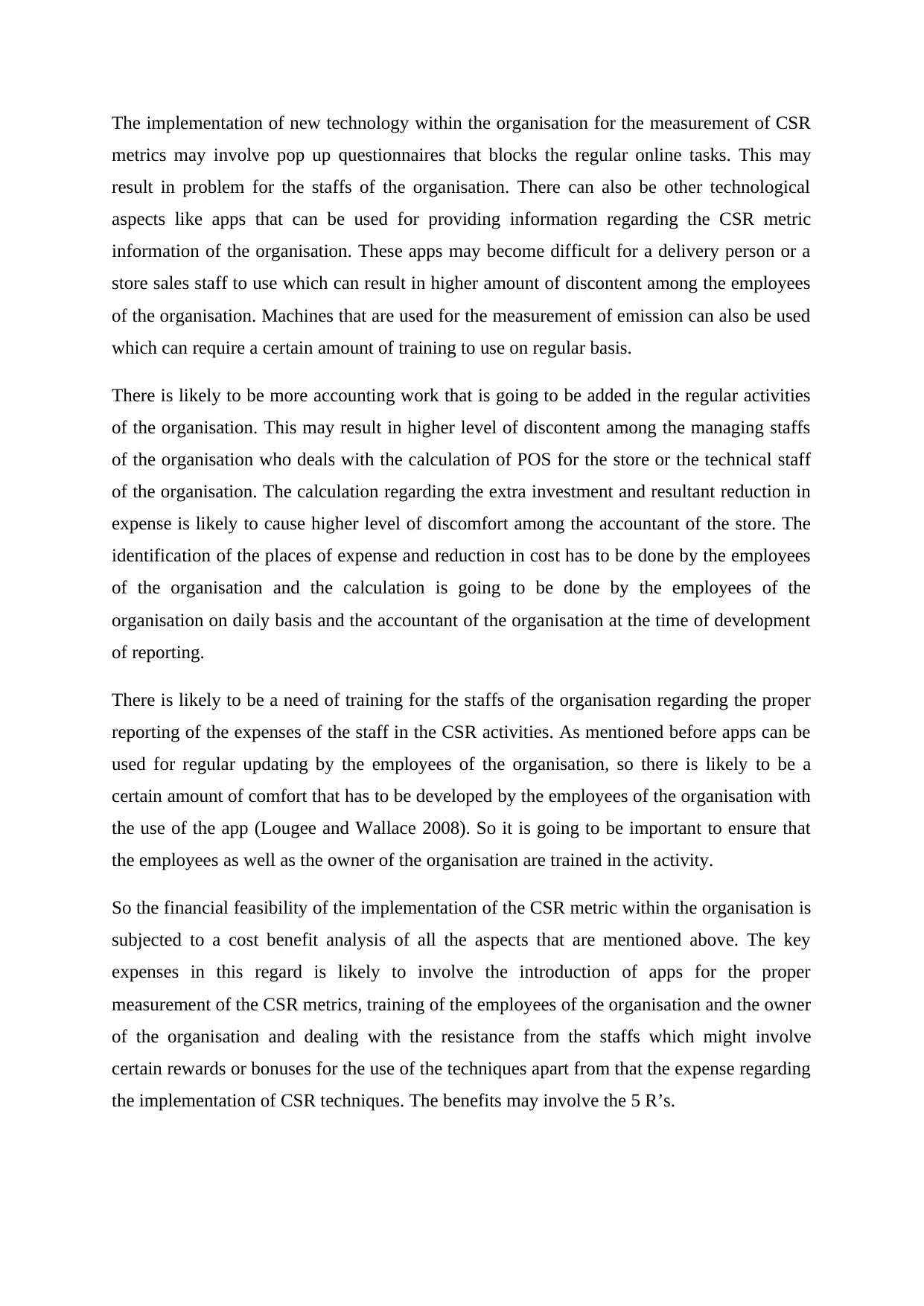
The implementation of new technology within the organisation for the measurement of CSR
metrics may involve pop up questionnaires that blocks the regular online tasks. This may
result in problem for the staffs of the organisation. There can also be other technological
aspects like apps that can be used for providing information regarding the CSR metric
information of the organisation. These apps may become difficult for a delivery person or a
store sales staff to use which can result in higher amount of discontent among the employees
of the organisation. Machines that are used for the measurement of emission can also be used
which can require a certain amount of training to use on regular basis.
There is likely to be more accounting work that is going to be added in the regular activities
of the organisation. This may result in higher level of discontent among the managing staffs
of the organisation who deals with the calculation of POS for the store or the technical staff
of the organisation. The calculation regarding the extra investment and resultant reduction in
expense is likely to cause higher level of discomfort among the accountant of the store. The
identification of the places of expense and reduction in cost has to be done by the employees
of the organisation and the calculation is going to be done by the employees of the
organisation on daily basis and the accountant of the organisation at the time of development
of reporting.
There is likely to be a need of training for the staffs of the organisation regarding the proper
reporting of the expenses of the staff in the CSR activities. As mentioned before apps can be
used for regular updating by the employees of the organisation, so there is likely to be a
certain amount of comfort that has to be developed by the employees of the organisation with
the use of the app (Lougee and Wallace 2008). So it is going to be important to ensure that
the employees as well as the owner of the organisation are trained in the activity.
So the financial feasibility of the implementation of the CSR metric within the organisation is
subjected to a cost benefit analysis of all the aspects that are mentioned above. The key
expenses in this regard is likely to involve the introduction of apps for the proper
measurement of the CSR metrics, training of the employees of the organisation and the owner
of the organisation and dealing with the resistance from the staffs which might involve
certain rewards or bonuses for the use of the techniques apart from that the expense regarding
the implementation of CSR techniques. The benefits may involve the 5 R’s.
metrics may involve pop up questionnaires that blocks the regular online tasks. This may
result in problem for the staffs of the organisation. There can also be other technological
aspects like apps that can be used for providing information regarding the CSR metric
information of the organisation. These apps may become difficult for a delivery person or a
store sales staff to use which can result in higher amount of discontent among the employees
of the organisation. Machines that are used for the measurement of emission can also be used
which can require a certain amount of training to use on regular basis.
There is likely to be more accounting work that is going to be added in the regular activities
of the organisation. This may result in higher level of discontent among the managing staffs
of the organisation who deals with the calculation of POS for the store or the technical staff
of the organisation. The calculation regarding the extra investment and resultant reduction in
expense is likely to cause higher level of discomfort among the accountant of the store. The
identification of the places of expense and reduction in cost has to be done by the employees
of the organisation and the calculation is going to be done by the employees of the
organisation on daily basis and the accountant of the organisation at the time of development
of reporting.
There is likely to be a need of training for the staffs of the organisation regarding the proper
reporting of the expenses of the staff in the CSR activities. As mentioned before apps can be
used for regular updating by the employees of the organisation, so there is likely to be a
certain amount of comfort that has to be developed by the employees of the organisation with
the use of the app (Lougee and Wallace 2008). So it is going to be important to ensure that
the employees as well as the owner of the organisation are trained in the activity.
So the financial feasibility of the implementation of the CSR metric within the organisation is
subjected to a cost benefit analysis of all the aspects that are mentioned above. The key
expenses in this regard is likely to involve the introduction of apps for the proper
measurement of the CSR metrics, training of the employees of the organisation and the owner
of the organisation and dealing with the resistance from the staffs which might involve
certain rewards or bonuses for the use of the techniques apart from that the expense regarding
the implementation of CSR techniques. The benefits may involve the 5 R’s.
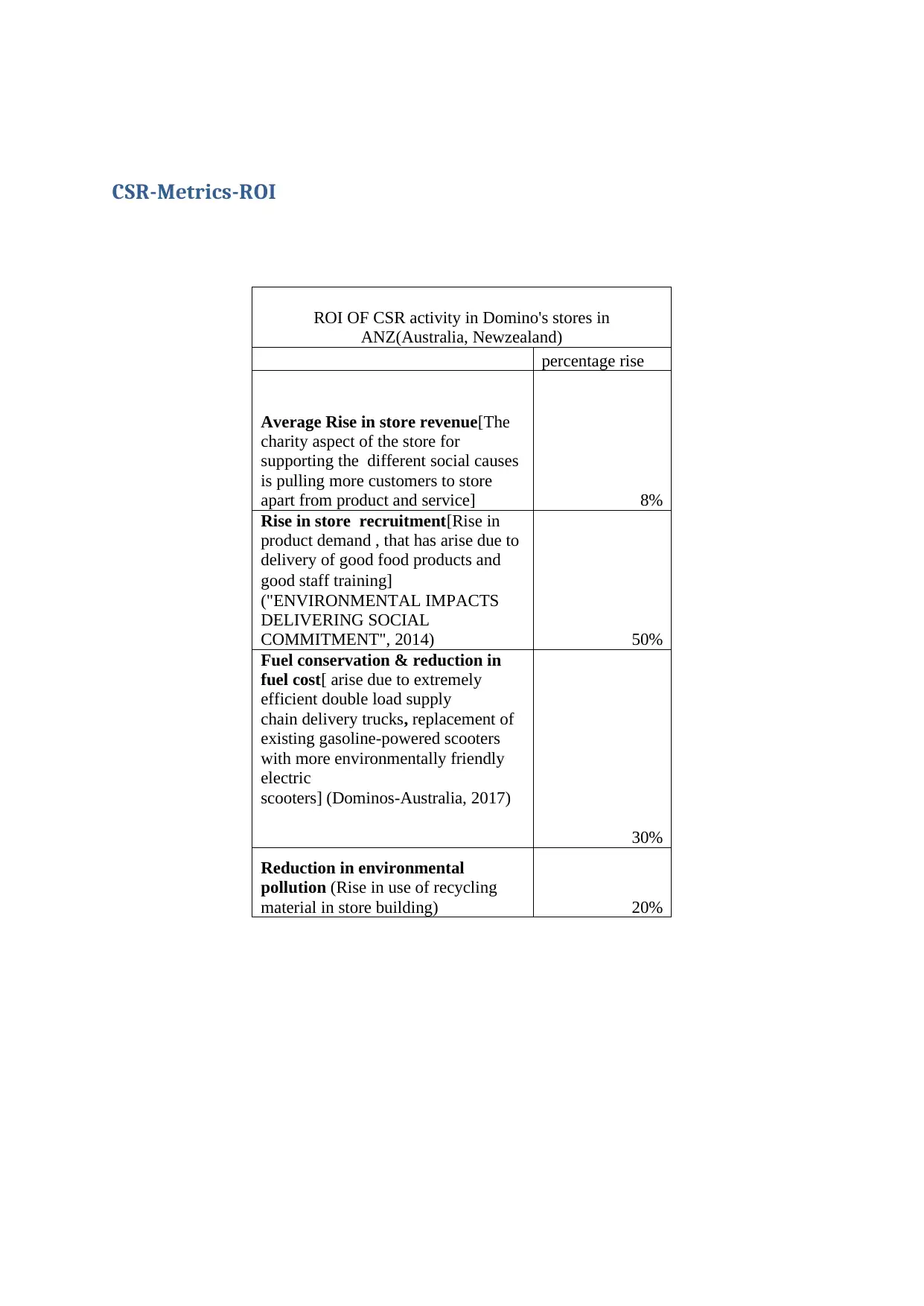
CSR-Metrics-ROI
ROI OF CSR activity in Domino's stores in
ANZ(Australia, Newzealand)
percentage rise
Average Rise in store revenue[The
charity aspect of the store for
supporting the different social causes
is pulling more customers to store
apart from product and service] 8%
Rise in store recruitment[Rise in
product demand , that has arise due to
delivery of good food products and
good staff training]
("ENVIRONMENTAL IMPACTS
DELIVERING SOCIAL
COMMITMENT", 2014) 50%
Fuel conservation & reduction in
fuel cost[ arise due to extremely
efficient double load supply
chain delivery trucks, replacement of
existing gasoline-powered scooters
with more environmentally friendly
electric
scooters] (Dominos-Australia, 2017)
30%
Reduction in environmental
pollution (Rise in use of recycling
material in store building) 20%
ROI OF CSR activity in Domino's stores in
ANZ(Australia, Newzealand)
percentage rise
Average Rise in store revenue[The
charity aspect of the store for
supporting the different social causes
is pulling more customers to store
apart from product and service] 8%
Rise in store recruitment[Rise in
product demand , that has arise due to
delivery of good food products and
good staff training]
("ENVIRONMENTAL IMPACTS
DELIVERING SOCIAL
COMMITMENT", 2014) 50%
Fuel conservation & reduction in
fuel cost[ arise due to extremely
efficient double load supply
chain delivery trucks, replacement of
existing gasoline-powered scooters
with more environmentally friendly
electric
scooters] (Dominos-Australia, 2017)
30%
Reduction in environmental
pollution (Rise in use of recycling
material in store building) 20%
⊘ This is a preview!⊘
Do you want full access?
Subscribe today to unlock all pages.

Trusted by 1+ million students worldwide
1 out of 15
Your All-in-One AI-Powered Toolkit for Academic Success.
+13062052269
info@desklib.com
Available 24*7 on WhatsApp / Email
![[object Object]](/_next/static/media/star-bottom.7253800d.svg)
Unlock your academic potential
Copyright © 2020–2025 A2Z Services. All Rights Reserved. Developed and managed by ZUCOL.

